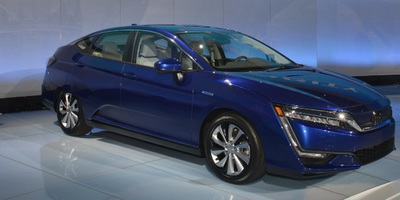New fuel cell system is half the size of the old unit and could be available for production as soon as 2015

New system uses one third the platinum
Yesterday, General Motors announced that it was testing a “production-intent” fuel cell system that is small enough to be packaged in the space of a traditional four-cylinder engine.
The new system is said to weigh 220 pounds less and use about a third of the platinum of the current system GM is using in a fleet of Chevrolet Equinox vehicles as part of its Project Driveway demonstration fleet.
“Our learning from Project Driveway has been tremendous and these vehicles have been very important to our program,” Charles Freese, executive director of GM's Global Fuel Cell Activities told reporters Tuesday at a news briefing on GM’s fuel cell progress.”
Although in its final phase, GM has stated that some of the vehicles involved in Project Driveway will receive both hardware and software upgrades and be loaned out to the U.S. Department of Energy, while others will be driven by businesses or used as demonstration vehicles.

In the meantime, Freese took the opportunity to present the keys to the first long-term “new look” Chevrolet fuel cell loaner vehicle to fuel cell advocate and blogger Stephanie White, who was also one of the early participants in the Project Driveway program.
“Driving the Chevy fuel cell around LA has been an amazing experience,” White said. “People are always stopping me to ask questions about the vehicle and I tell them how powerful and eco-friendly it is.”

You've come a long way, baby, since 1966
GM’s dedication to fuel cell technology dates back more than four decades when, in 1966, the company applied technology used during the Apollo Space Program to produce the world’s first fuel cell powered vehicle, the 1966 GM Electrovan.

Based on the GMC Handivan, the Electrovan took advantage of the scientific strides made possible by U.S. space program that had produced modules of sufficient power density to make an experimental vehicle possible.
According to an article written by GM’s Bill Bowman, “Electrovan’s fuel cell powerplant supplied a continuous output of about 32 kilowatts and a peak output of 160 kilowatts. It consisted of 32 thin-electrode fuel cell modules connected in series. The motor and control system on the Electrovan were mounted between and under the two front seats. Located beneath the floor were the 32 fuel cell modules interconnected by some 550 feet of plastic piping. Also part of the installation were cryogenic hydrogen and oxygen tanks and an electrolyte reservoir mounted behind the middle bench seat. About 45 gallons of potassium hydroxide were required to fill the modules, the piping and the reservoir. This electrolyte alone weighed 550 pounds bringing the van’s total weight to 7,100 pounds.”

Although the Electrovan had a range of nearly 150 miles, its 7,100 pound curb weight meant that performance figures rapidly deteriorated from that point with a top speed of just 70 miles per hour while zero to sixty times could’ve been just as easily measured by an hourglass as by a stopwatch at 30 seconds.
In the end, the Electrovan project was scrapped after the single vehicle was produced due to its “cost-prohibitive” nature. According to Bowman, “The platinum used in the fuel cell was enough to ‘buy a whole fleet of vans’ and there was absolutely no supporting hydrogen infrastructure in place at that time.”













